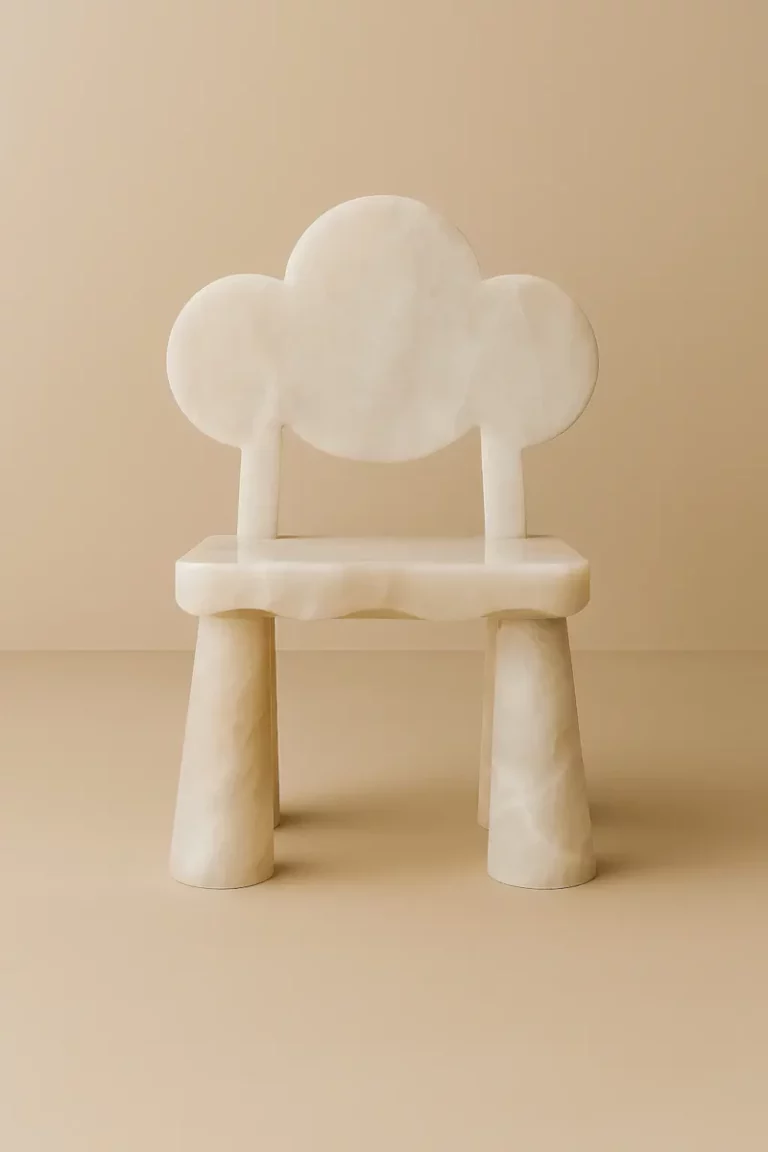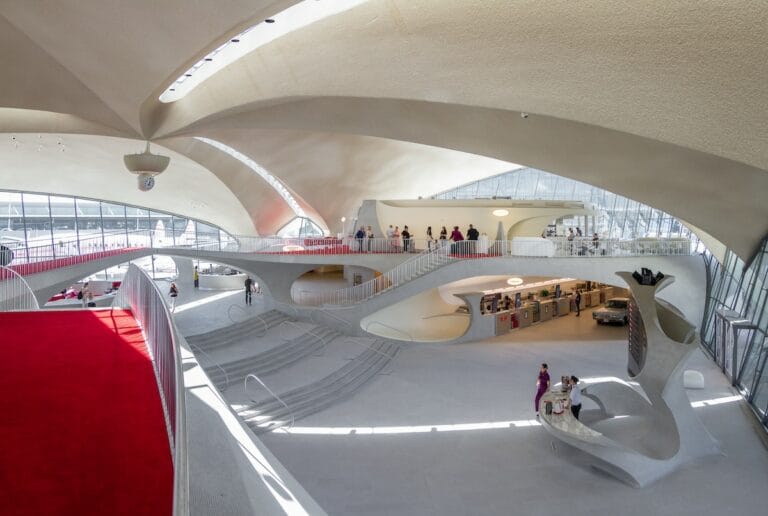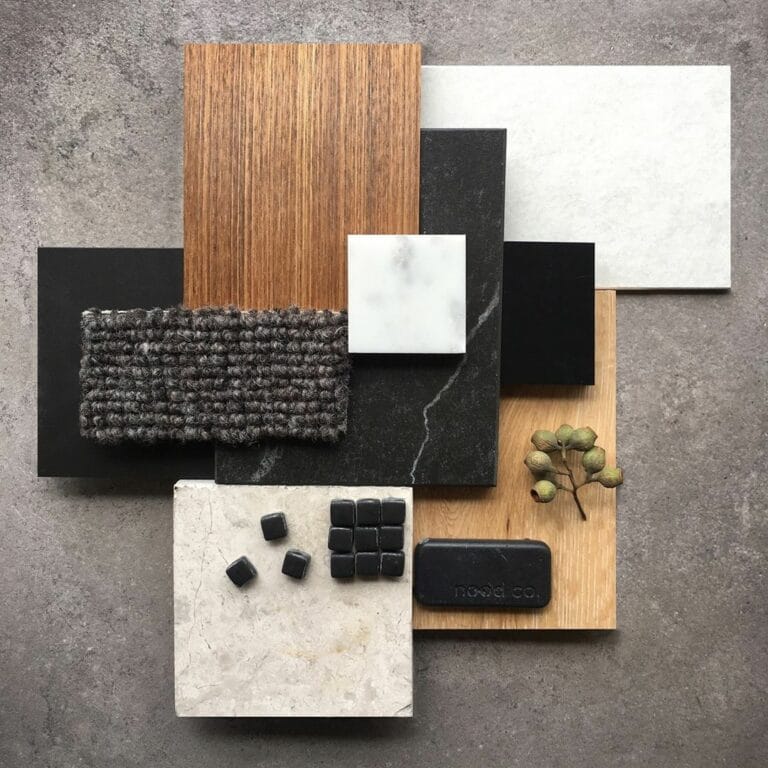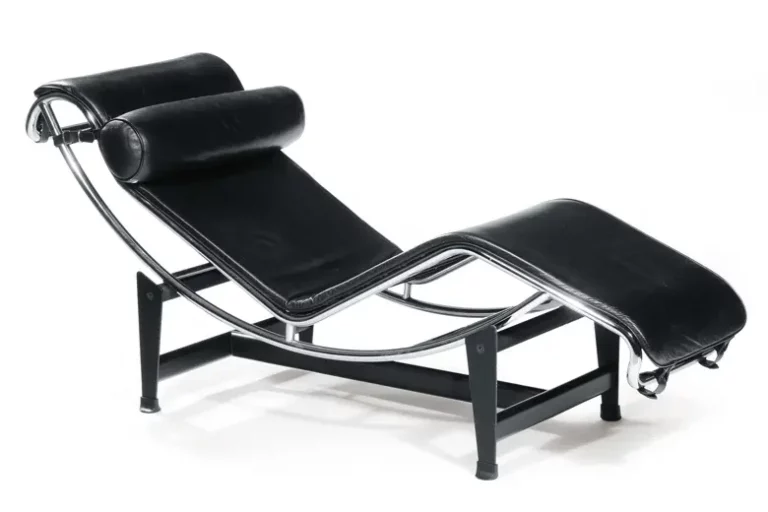When Milan Reinvents Daily Life Through Industrial Beauty
Milan, 1954. In the workshops of Via Durini, Gio Ponti contemplates a Chiavari peasant chair that is one hundred and fifty years old. Around him, Italy is rising from its ashes with a vigor that astonishes all of Europe. That afternoon, Ponti decides to reinvent this anonymous seat to make it the lightest object in the modern world. He doesn’t yet know that he has just laid the first stone of a revolution that will transform international design and make Milan the world capital of contemporary living.
Between 1950 and 1980, Italian design orchestrates an unprecedented symphony where centuries-old craftsmanship dialogues with industrial production, where Northern functionalist rigor is tinged with Mediterranean hedonism. After the rigorous purism of pre-war rationalism and parallel to traditional Scandinavian design, Italy invents a third way: that of emotional design, sensual, sometimes playful, always deeply rooted in a culture that refuses to separate art from life.
Historical & Cultural Context: The Italian Miracle
Italy in 1945 was bloodless, but by 1948, the country began a stunning economic recovery, driven by the Marshall Plan and above all by a craft tradition that never faltered. Small family businesses transformed into modern manufacturers without abandoning their ancestral quality standards, as evidenced by the evolution of brands such as Boffi in the luxury kitchen sector.
This context explains the singularity of Italian design: it was born from the encounter between the heritage of Renaissance botteghe and the imperative of industrial production. Unlike the German Bauhaus, which dreamed of an aesthetic tabula rasa, Italian design assumes a cultural continuity: that of a country that has never ceased to consider beauty as a vital necessity.
The miracolo economico of the 1950s-1960s transformed society. Visionary publishers like Cesare Cassina, Dino Gavina, or Sergio Gandini at Flos understood that design could reconcile mass production with authored creation. The arrival of plastic materials – polyurethane, ABS, polypropylene – offered unprecedented formal freedom that would characterize 1960s design. Kartell, founded in 1949, became the laboratory of this material revolution.
The Triennale di Milano, an institution founded in 1923, became the theater of this creative effervescence. Every three years, designers, architects, and industrialists presented their innovations, transforming Milan into the world capital of design. The Compasso d’Oro, created in 1954, consecrated this Italian excellence by rewarding the best industrial creations.
Aesthetic Characteristics: A Grammar of Sensuality
How do you recognize an Italian design object? By a sculptural approach where each chair, each lamp, each sofa becomes an inhabited sculpture. Italian designers prefer organic curves, rounded volumes, dynamic balances that give the impression that the object is about to move. This sensitivity to natural forms is part of an organic design logic that reconciles nature and functionality.
The chromatic palette constitutes an immediate signature. Vermillion reds, blood oranges, emerald greens, lemon yellows explode in 1960s interiors. This joyful polychromy reflects Mediterranean light and a taste for contrast. Sottsass, with his bright red Valentine, embodies this chromatic revolution that refuses the administrative gray of post-war offices.
Materials tell this story of hybridization between tradition and modernity. Carrara marble sits alongside injected plastics, Murano blown glass integrates contemporary lighting fixtures produced by the great design lighting houses. Polyurethane foams, revolutionary in the 1960s, made it possible to sculpt organic forms impossible with traditional springs. This attention to the tactile dimension reflects a Mediterranean culture where physical contact plays a fundamental social role. Leather, worked according to centuries-old techniques in Tuscan workshops, covers Cassina or B&B Italia sofas with a warm patina that improves with time.
Creators & Key Figures
Gio Ponti: The Democratic Aristocrat
Born in 1891 in Milan, Ponti embodies the transition between bourgeois elegance and industrial modernity. He founded the magazine Domus in 1928, which would become the bible of international design and which he would direct until his death in 1979. His conviction: beauty must irrigate all aspects of daily life, from the spoon to the city. By opening the pages of Domus to young creators, he played a role as a ferryman between the avant-garde and the general public, publishing the early works of Sottsass, Castiglioni, Magistretti before they became famous.
Achille Castiglioni: The Poet of the Ready-Made
Achille Castiglioni (1918-2002) represents brilliant mischievousness. Graduated from the Politecnico di Milano in 1944, he opened a studio with his brothers Livio and Pier Giacomo. This fraternal collaboration, rare in design history, would last until Pier Giacomo’s premature death in 1968. The Mezzadro stool (1957) mounts a tractor seat on a steel spring and curved wooden base: a playful seat that transforms the act of sitting into a dynamic experience. Rejected by all publishers for fifteen years – too bizarre, too conceptual – it would finally be produced by Zanotta in 1971.
His teaching at the Politecnico di Milano, from 1969 to 1993, marked generations of students. In his studio-museum at Piazza Castello in Milan, now preserved by the Fondazione Achille Castiglioni, a collection of objects gleaned from flea markets is piled up: bicycle saddles, industrial springs, old light bulbs. Each constitutes a reserve of forms, a visual alphabet from which the designer draws to compose his creations.
Ettore Sottsass: The Mystical Rebel
Ettore Sottsass (1917-2007) embodies the designer-philosopher. A trip to India in 1961 transformed his vision: he discovered tantric temples and Hindu spirituality, understanding that objects are not simple functional tools, but vectors of meaning that mediate our relationship to the world. This spiritual dimension, rare in Western design, irrigates all his work.
His Valentine typewriter for Olivetti (1969), scarlet red and portable, proclaims that office equipment can be desirable and liberating. The advertising campaign, photographed by Hans Hartung, showed the Valentine in incongruous contexts: on a beach, in a park, far from the constraining universe of the office.
In 1981, Sottsass founded the Memphis collective with Michele De Lucchi, Matteo Thun, and other young creators. The name, chosen during an evening when Stuck Inside of Mobile with the Memphis Blues Again by Bob Dylan was playing on loop, set the tone. The furniture – Carlton bookcases with multicolored geometric stacks, Casablanca console with totemic forms – cited Art Deco, Futurism, African motifs in a jubilant collage. Memphis became a global media phenomenon, exhibited at the Metropolitan Museum of Art in 1982, profoundly influencing 1980s aesthetics.
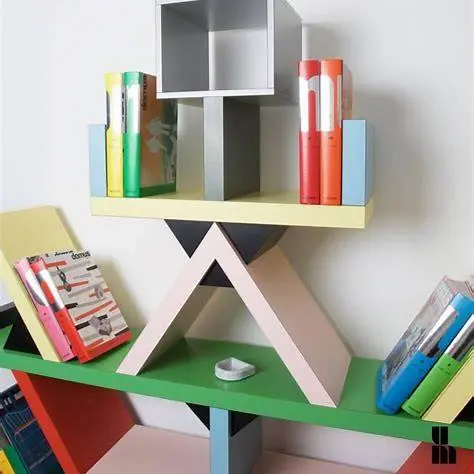
Vico Magistretti: The Sensitive Rationalist
Vico Magistretti (1920-2006) purifies and harmonizes with an almost Zen discretion. An architect by training, graduated from the Politecnico di Milano in 1945, he mainly built residential buildings in Milan and villas on the Lombard lakes that reveal a modernism sensitive to contexts.
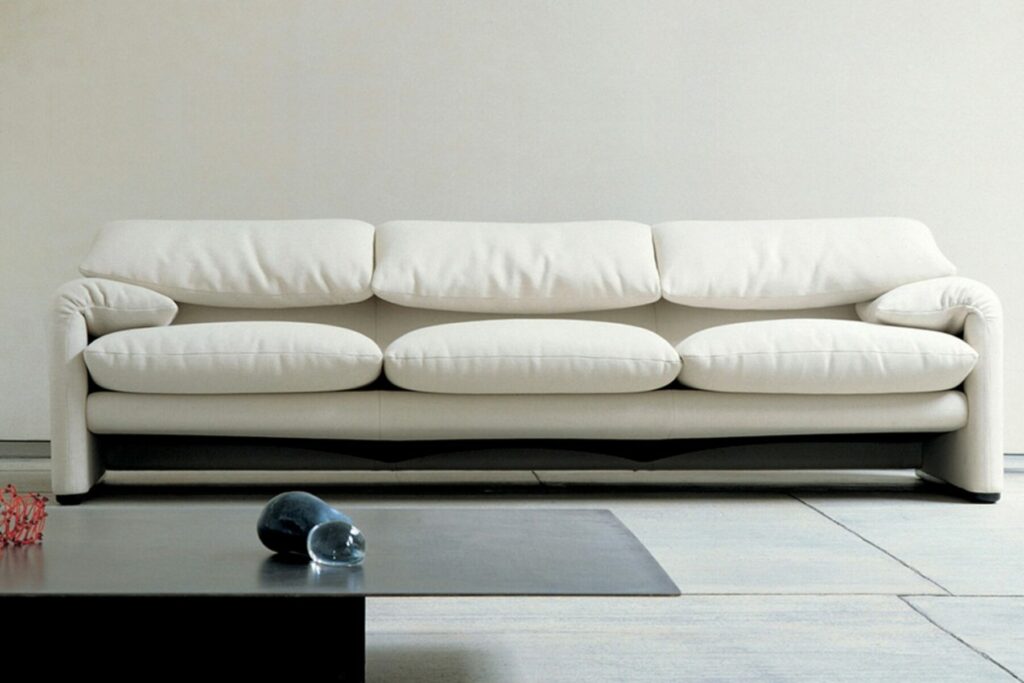
His Maralunga armchair for Cassina (1973) integrates a backrest whose height is adjusted by a simple hand movement, with no visible mechanism. Folded, it offers a low, relaxed seat. Deployed, it becomes an enveloping reading chair. This invisible modularity – the adjustment is made by an ingenious system of straps and hidden springs – testifies to Italian technical refinement: sophistication in the service of comfort, never demonstration. Compasso d’Oro 1979, in continuous production for fifty years. We have explored in depth the history and heritage of the Maralunga, this timeless icon of Italian design.
Mario Bellini: The Architect of Comfort
Mario Bellini (born in 1935 in Milan) makes comfort an absolute priority without sacrificing formal boldness. An architect graduated from the Politecnico di Milano in 1959, design consultant for Olivetti from 1963 to 1991, he designed typewriters and calculators before revolutionizing seating furniture.
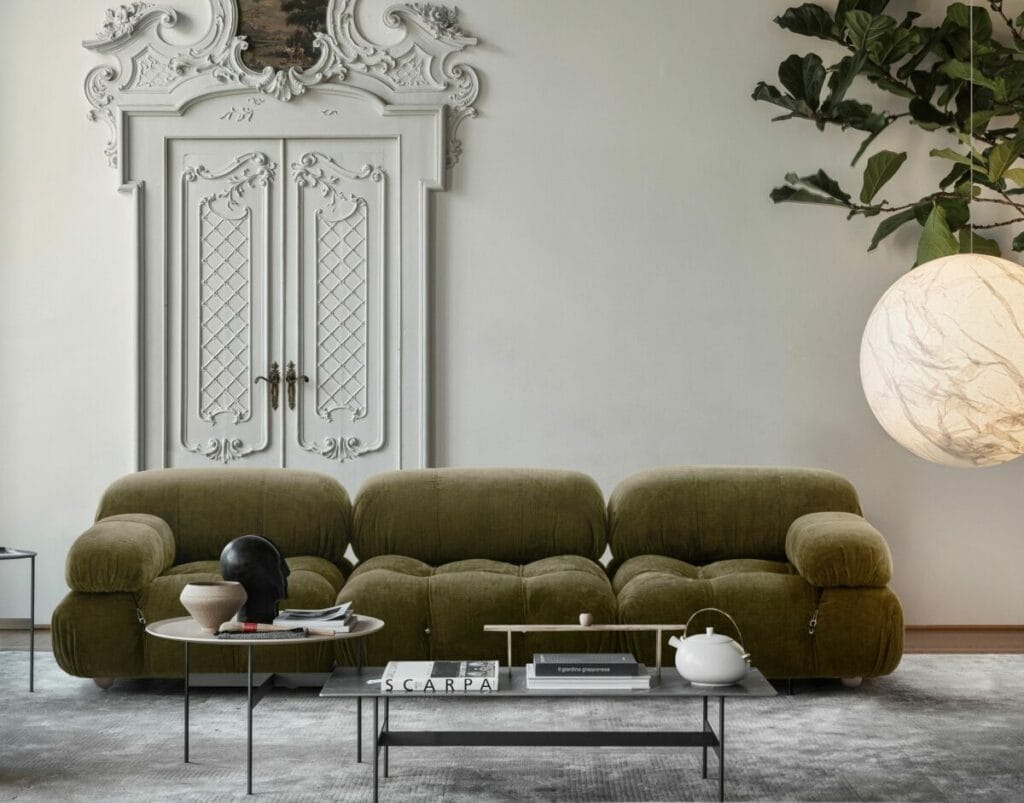
His Camaleonda sofa for B&B Italia (1970-1971) revolutionized furniture: modules entirely padded with polyurethane foam, without apparent rigid structure, which assemble freely by a metal strap system. Each element can combine to create infinite configurations: straight line, L-shaped composition, U-shaped, central island, chaise lounge. This radical modularity responds to the libertarian aspirations of the 1970s: the user becomes composer of their own space, reconfigurable according to needs and moods. The organic, curved, almost anthropomorphic forms create inhabited landscapes that invite lounging. Compasso d’Oro 1972, triumphantly reissued in 2020. The Camaleonda embodies the modular sofa that continues to revolutionize contemporary living rooms.
Joe Colombo: The Dazzling Visionary
Joe Colombo (1930-1971) embodies the tragic figure of precocious genius. Forty-one years old: that’s the age at which a heart attack took him, brutally interrupting a career that had barely begun ten years earlier. Yet in this dazzling decade, Colombo produced some of the most prophetic visions of Italian design, anticipating modular housing, multifunctional spaces, home automation before the term even existed. His Tube Chair (1969-1970), composed of four foam tubes covered with stretch fabric, foreshadowed flexible living. His Boby Trolley (1970), a wheeled trolley in molded ABS, became a classic of office furniture.
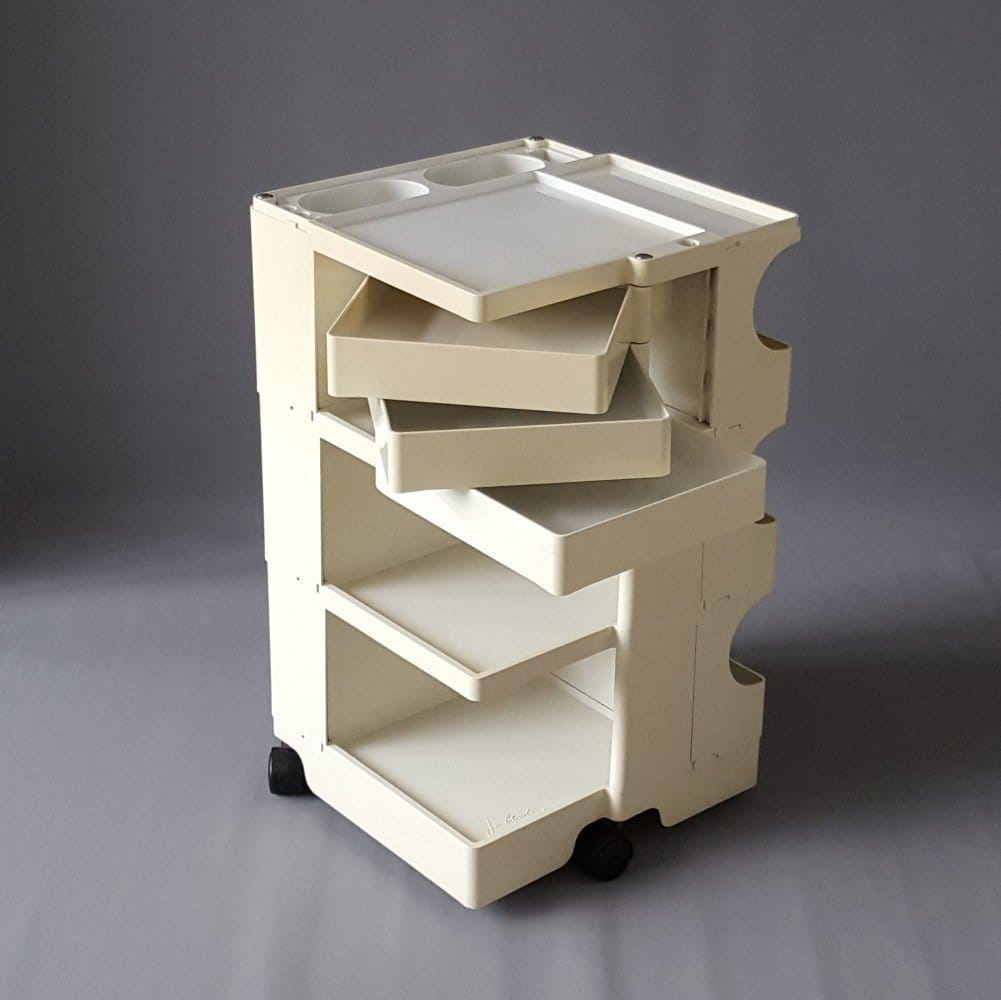
Architecture: The Monumental Scale
Torre Velasca, Milan (BBPR, 1958): this 106-meter brutalist tower, designed by the studio BBPR (Banfi, Belgiojoso, Peressutti, Rogers), breaks with modernist orthodoxy. Its flared top, reminiscent of medieval Milanese towers and the Castello Sforzesco, sparked immediate controversy. Purists saw it as a betrayal of rationalism, contextualists as an intelligent reconciliation between past and present. Now rehabilitated, it embodies an Italian brutalism sensitive to urban history.
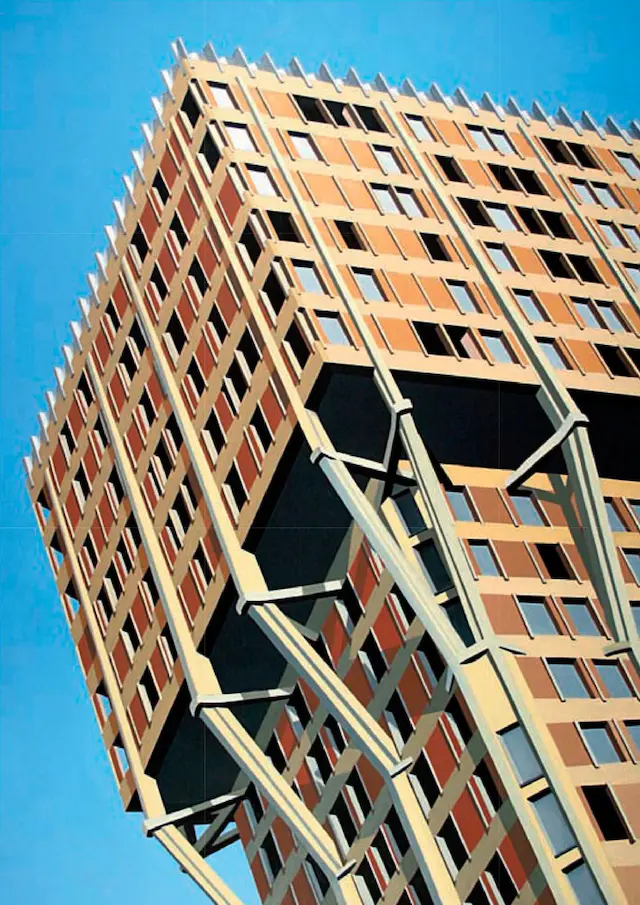
Pirelli Tower, Milan (Ponti, 1958): Italy’s first skyscraper, 127 meters high, designed with engineer Pier Luigi Nervi. The reinforced concrete structure calculated by Nervi allows for remarkable facade fineness, with only 70 centimeters of floor thickness. Every detail, from elevators to door handles, is designed by Ponti in a logic of total design. The building immediately became the icon of Italian modernity and the symbol of Milanese design.
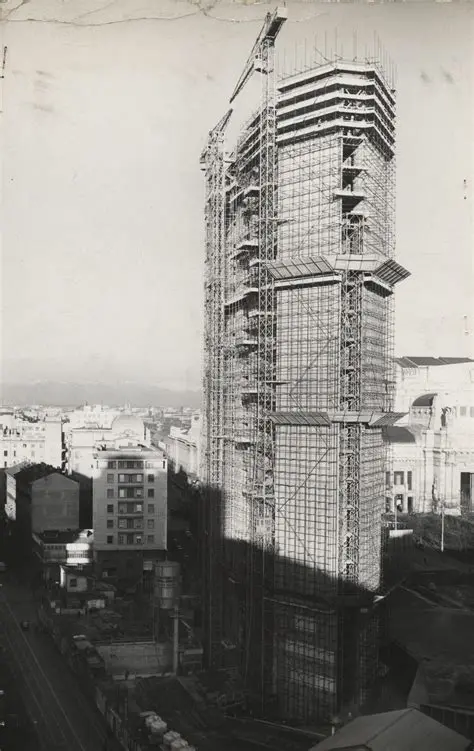
Olivetti Showrooms: commercial spaces become aesthetic manifestos. The showroom designed by Carlo Scarpa in Venice (1958), Piazza San Marco, transforms the boutique into a design sanctuary with its floating display cases and suspended staircase. Sottsass designed the Parisian showroom, creating a total experience where architecture, furniture, and products dialogue harmoniously.
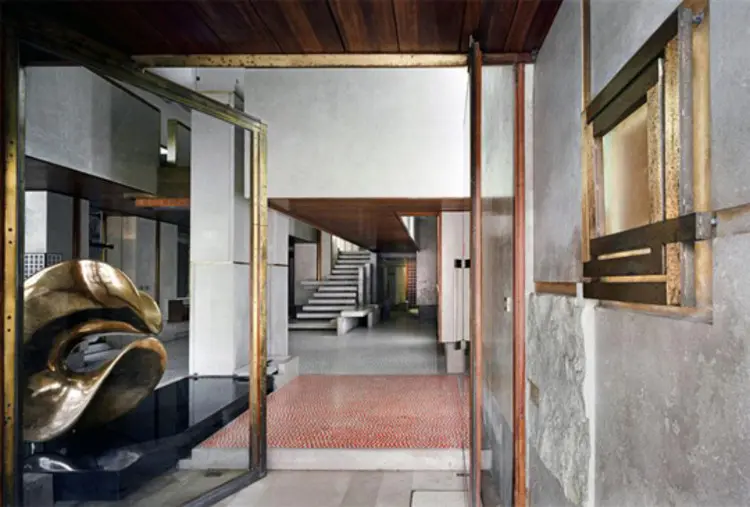
Furniture & Representative Objects
Maralunga Sofa (Magistretti/Cassina, 1973)
The Maralunga embodies the discreet intelligence of Italian design. Its adjustable backrest unfolds or folds with a gesture, moving from a low position (85 cm) to a high enveloping backrest (110 cm). The mechanism, based on a patented spring and elastic strap system, remains invisible. Upholstered in leather or fabric, with generous proportions (seat depth of 60 cm), it crosses the decades without aging. Available as an armchair, two or three-seater sofa. Compasso d’Oro 1979, in continuous production for fifty years.
Camaleonda Sofa (Bellini/B&B Italia, 1970-1971)
The Camaleonda represents a revolutionary system of fully padded modules that assemble freely. Six types of elements: backs, seats, armrests, corners, footrests. Infinite configurations according to space and use. Organic forms break with the rectitude of traditional furniture. Upholstery in fabric or leather, bold chromatic palette including orange, burgundy, olive green. Triumphant reissue in 2020 with contemporary colors that appeal to millennials seeking domestic flexibility. Compasso d’Oro 1972.
Le Bambole Sofa (Bellini/B&B Italia, 1972)
Literally “the dolls”: armchairs and sofas with rounded forms, entirely padded without visible rigid structure. Bellini continues his exploration of sensual comfort with these almost naive volumes that evoke giant plush toys. This anti-monumental, almost childlike approach reflects the spirit of the 1970s: refusal of formalism, search for relaxed conviviality. The generous proportions, deep tufting, rounded armrests create a domestic cocoon.
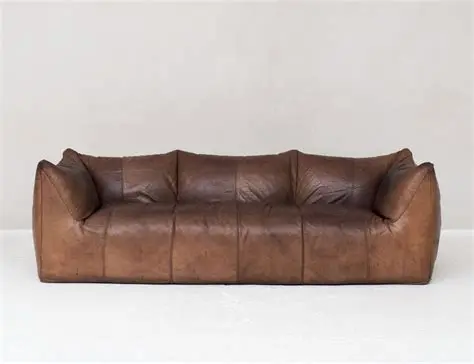
Eclisse Lamp (Magistretti/Artemide, 1967)
Two spherical shells in lacquered metal, one fixed, the other rotating, modulating intensity by progressive eclipse. No electronic dimmer, just a simple and rewarding gesture that educates the user. Available in white or in vivid shades characteristic of the 1960s. Perfect geometry in service of a domestic function. Compasso d’Oro 1967, MoMA permanent collection. A perfect example of the excellence of Italian design lighting houses.
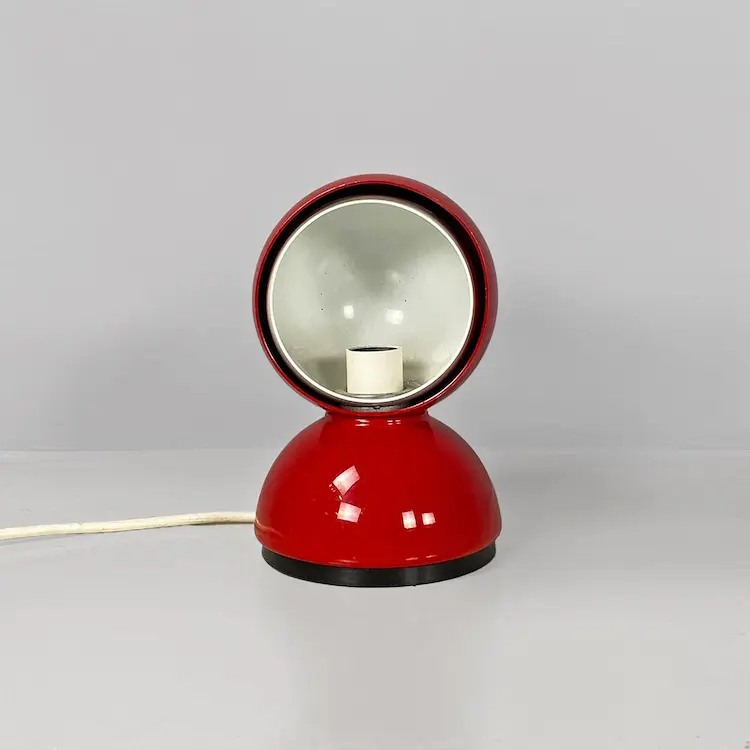
Atollo Lamp (Magistretti/Oluce, 1977)
Three pure geometric volumes – cylinder (base), truncated cone (tray), hemisphere (diffuser) – stacked like a still life by Giorgio Morandi. Height 70 cm, available in opaline white or black. The light, diffused by the upper hemispherical bowl, reflects on the circular tray and creates soft indirect lighting. Geometric abstraction that never verges into coldness. Absolute icon of the 1970s, produced by Oluce, one of the historic Italian lighting houses.
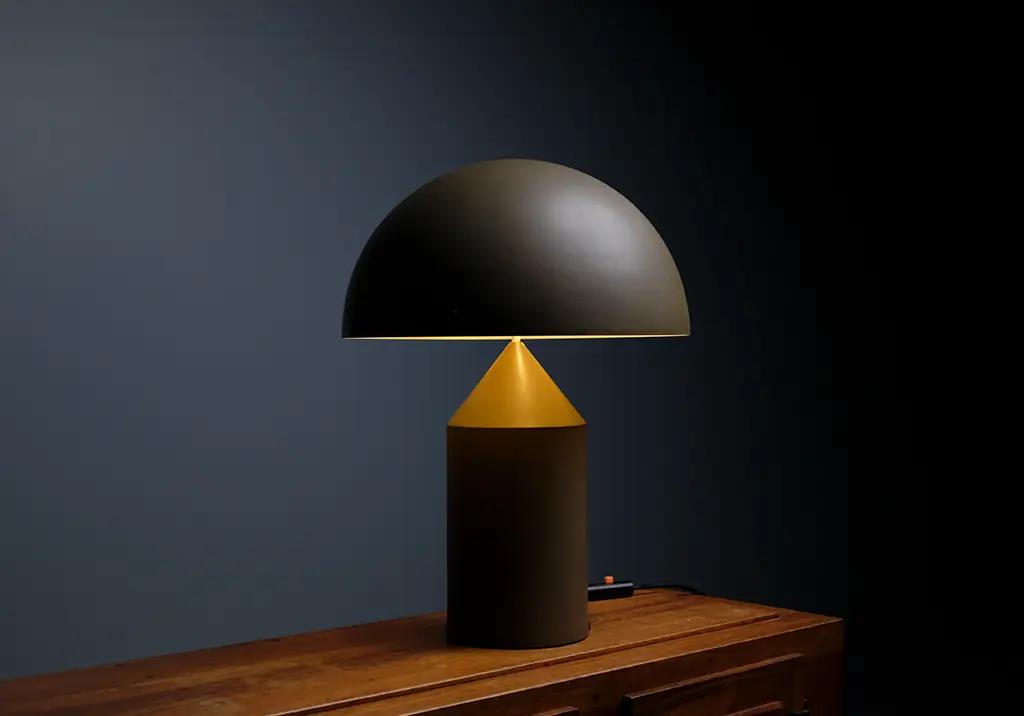
Valentine Typewriter (Sottsass/Olivetti, 1969)
Molded ABS casing in scarlet red, weight of only 4 kg. Delivered in a matching case. Manifesto of an era that dreams of mobility and freedom, the Valentine proclaims that work can emancipate itself from the traditional office. Production from 1969 to 1979, over 7 million units sold. MoMA permanent collection, icon of 1960s design.
Heritage & Reinterpretations
The influence of Italian design irrigates all international postmodern design. Philippe Starck, in his early creations for the Bains Douches or Café Costes in the 1980s, explicitly cites the Italian masters. Jean Nouvel acknowledges his debt to Sottsass in his early colorful architectures. The Dutch Droog Design movement of the 1990s, with its conceptual and playful approach, extends the Castiglioni lesson of poetic diversion.
Reissues testify to the permanence of these creations. Cassina maintains in its catalog the I Maestri collection that revives the classics of Ponti, Magistretti, Albini. B&B Italia reissued the Camaleonda in 2020 with immediate commercial success: younger generations, seeking modularity and second life for their objects, are rediscovering these flexible systems invented fifty years earlier.
Current emotional design, carried by agencies like Formafantasma (Andrea Trimarchi and Simone Farresin) or Martino Gamper, explicitly claims Italian filiation. Attention to materials, refusal of cold technicism, the narrative dimension of objects: so many markers coming directly from the post-war Italian school, as we explore in our articles on contemporary Italian design.
Current Market & Prices
New Purchase
Cassina offers the Maralunga between €8000 (fabric armchair) and €15000 (three-seater leather sofa). B&B Italia markets the Camaleonda from €12000 for a minimal composition of four modules, reaching €40000 for large custom configurations. Le Bambole starts at €6000. Lamps remain more affordable: Eclisse at €400, Atollo at €800 (table version) and €1500 (floor version).
Second Hand
Platforms 1stDibs, Pamono, Catawiki offer authentic pieces. A vintage Maralunga in good condition sells for between €3000 and €6000, an original 1970s Camaleonda can reach €15000
Resources
Design Fundamentals
The Big Design History
From baroque salons to the radical lines of the 20th century, this timeline highlights the aesthetic revolutions that have shaped our everyday environment.
Read the page “The Big Design History”Hart Dictionary of Great Design Names
This dictionary lists the great names of design and decoration in alphabetical order. Discover the creators who have shaped contemporary art de vivre.
Read the page “Hart Dictionary of Great Design Names”History of Classic French & European Decorative Styles
Empire, Regency, Louis XV, Art Deco… This guide summarizes the decorative codes of each major European style.
Read the page “History of Classic French & European Decorative Styles”Hart Design Glossary A–Z
Sabre leg, patina, trimmings, caning… This glossary explains the technical and stylistic terms commonly used in the world of design and decoration.
Read the page “Hart Design Glossary A–Z”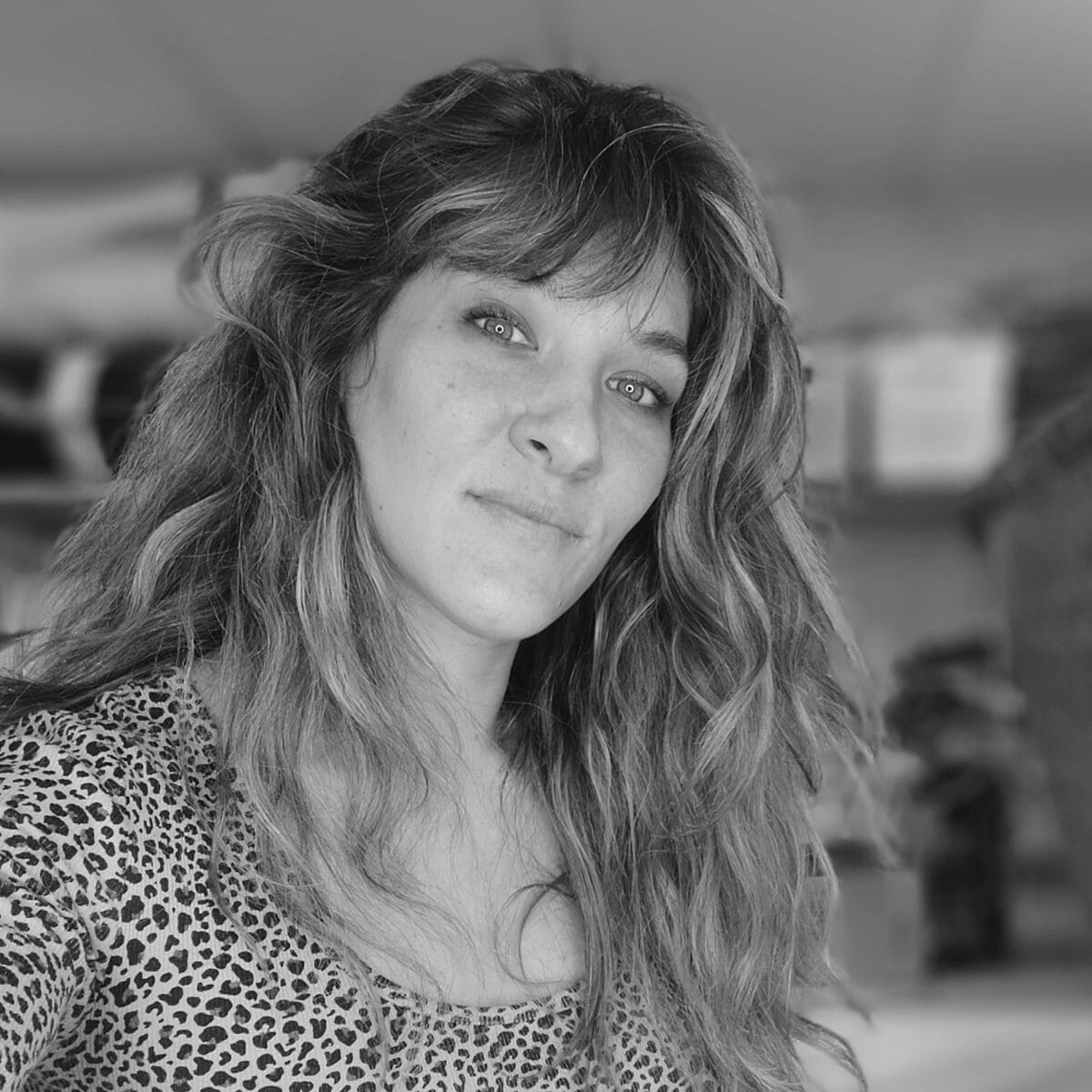
Digital entrepreneur and craft artisan, I use my unconventional background to share my vision of luxury design and interior decoration — one enriched by craftsmanship, history, and contemporary creation. Since 2012, I have been working daily in my workshop on the shores of Lake Annecy, creating bespoke interiors for discerning decorators and private clients.


